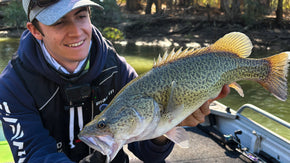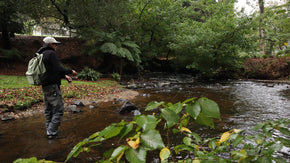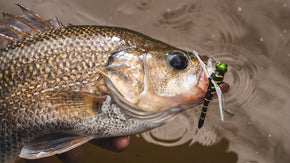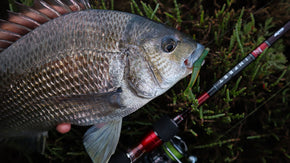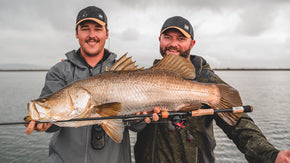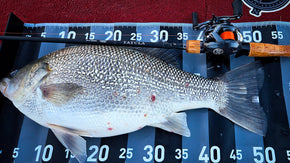Posted 06th July 2022
How to Catch King George Whiting in Port Phillip Bay
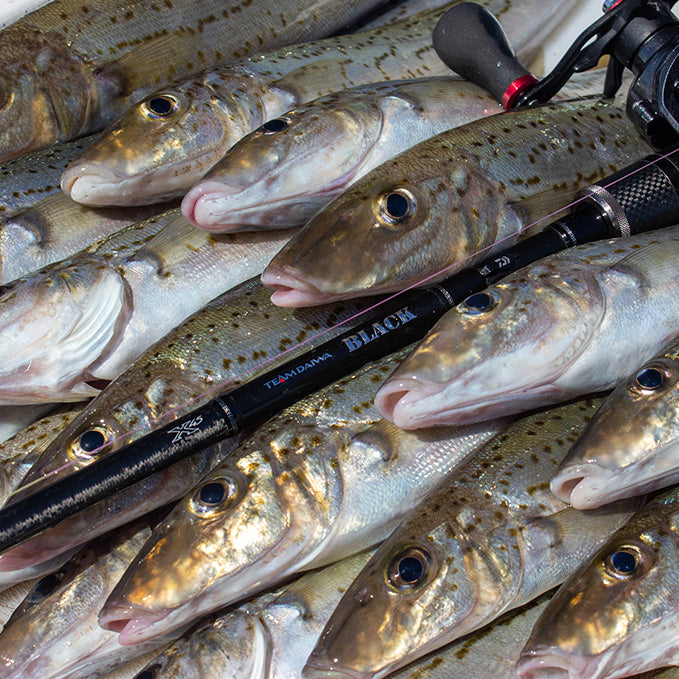
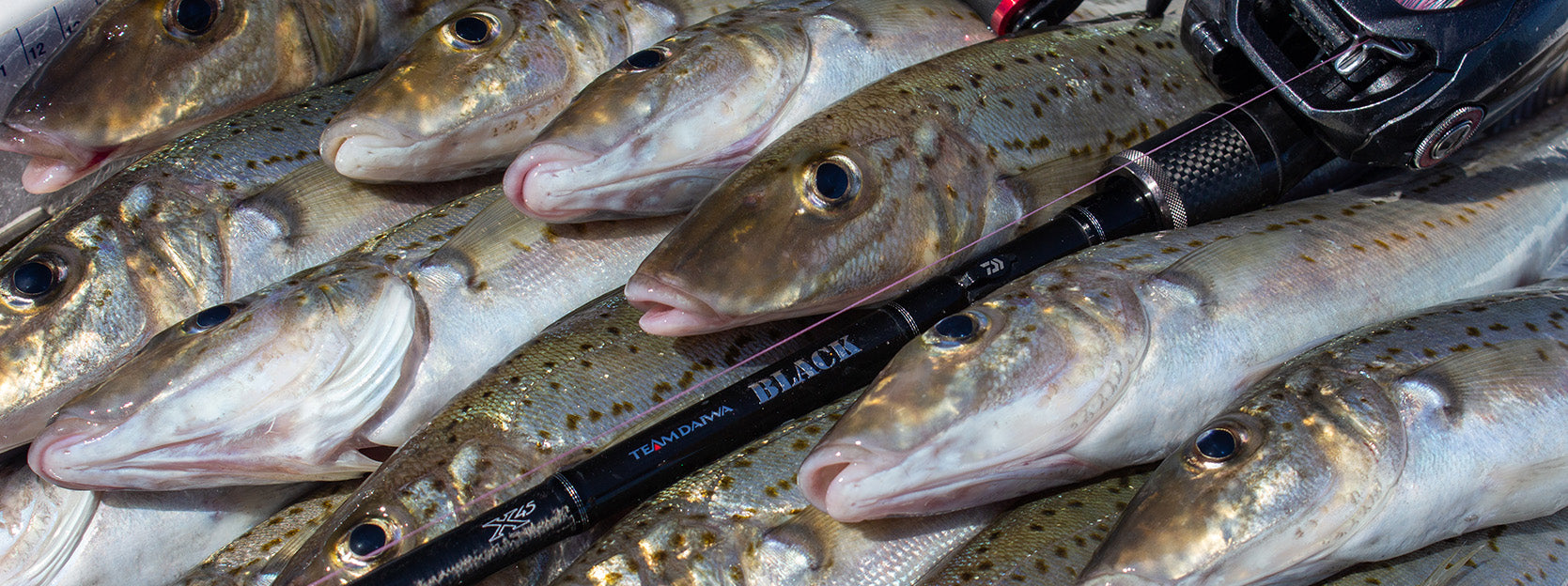
By Robert Thornton
Many of us fish to relax, unwind, and disconnect from the chaotic world around us. For the outdoor-inclined, you really can’t beat a bit of bait fishing for relaxation, and King George whiting are a great ‘bread and butter’ fish to escape the grind. There really is no better example of a top quality King George fishery on the doorstep of a bustling, worldly city than the one in Port Phillip Bay.
It’s not difficult to do, but not super easy either, making it a comfortable challenge for most anglers. These little battlers fight hard, move about in schools, can reach several kilos, and can be targeted with any light spin setup. Anyone with kids can introduce them to the sport with this species, while also having a great time themselves. They can be targeted reliably in many estuary, inshore and offshore areas along the south coast of Australia, with Sydney in NSW and Jurien Bay in WA their approximate northern limits. Some honking specimens can also be found in Tasmania. Oh, and they plate up good. Real good!
Daiwa Australia’s range of light spin gear and accessories not only facilitate this style of fishing, but also gives anglers options depending on their preferences and budgets.
But before we get into the process of finding and catching these gargantuan whiting, let’s delve into some royal history!

A King’s Welcome
You might be thinking that King George whiting is a strange name for a fish, and it certainly is! The name comes from the first specimen described by French naturalist Georges Cuvier in 1829. This specimen was captured in the already named King George Sound on the south coast of WA. They often get called spotted whiting, particularly in markets.
This is important to know, because in the last few decades KGs numbers have been threatened by overfishing from the commercial sector. Many anglers probably never considered the damage that was being done to the fishery, partly because they ordered ‘spotted whiting’ from their fish and chip shop.
In the last decade, scientists started to notice poor settlement and recruitment in Port Phillip Bay, and this is likely due to a few reasons. Firstly, the numbers that were netted by the commercial fishery were reaching an unsustainable level, and the methods of netting were damaging to seagrass and gravel beds that KGs live around.
Jesse Rotin has chased KGs in Port Phillip Bay for many years, and has witnessed changes to the fishery.
“I think a lot of whiting that used to come through got taken by the pros,” he explains, “I remember I used to go out with the old man and we’d catch them one day, and then the next day there was not a whiting to be seen.”
“And then we’d notice that these areas suddenly didn’t have sea grass on them, and this is probably because they’d dragged nets through there.”
Fighting for Whiting
As of March this year, all commercial netting has ceased in Port Phillip Bay, with some line fishing methods still allowed but heavily regulated. This is great news for not just whiting fans, but anyone who fishes around Port Phillip. The Victorian Government’s ‘Target One Million’ project to sell one million recreational fishing licenses has been a significant driver in repairing the Port Phillip fishery. Announced in 2014, one of the promises was to halt commercial netting in Port Phillip Bay over eight years, and they’ve certainly achieved that.
Government policy like this acknowledges the economic boost generated by a recreational fishery, and the vested interest the rec sector has in keeping our fisheries healthy. Funding via recreational fishing licenses is making all this possible, and it really highlights how important having a strong rec sector is. Things are looking good going forward, and anglers like Jesse are excited for the future prospects.
“I’ve noticed a lot more anglers reporting better numbers, and also a good mixture of sizes,” he says,”They’ve been turning up in new spots too!”

Finding the Ground
Most anglers choose to target these highly mobile schooling fish around shallow areas of seagrass, gravel and rock, and Jesse is no different.
“I find that where I’ll catch squid, I also find whiting,” he explains, “That same sort of depth around 2-4m seems to be a really good depth.”
“Fishing shallower than 2m is possible, but you need a bit of chop on the water; it’s the opposite on a calm day – they’ll be deeper.”
Jesse doesn’t worry himself too much with the tide or moon phases, opting to get out when he has the time available. There are conditions more conducive to success, however.
“If the water’s a bit clearer or I’m fishing shallower, low light conditions can be good,” he says. “Sometimes the water can be a bit dirtier as the tide is going out, and this can provide them with a bit of cover too if they’re a bit spooky.”
Time of year isn’t as important to this type of fishing as anglers once thought it was, and there isn’t really any season when they can’t be caught. With that said, better numbers of fish seem to come during warmer months.
“It used to be considered more a spring and summer thing,” Jesse says, “When I was younger, we didn’t even try for whiting in winter, but with lot more people are out there in winter and spreading the word now, it’s given the fishery some exposure, and we’re actually seeing good numbers of fish coming through winter as well.”
No doubt the net ban will also have a positive effect on whiting numbers in winter.
Berleying is a tool anglers can use to find whiting, but it’s definitely not vital to success, and if you ask Jesse, sometimes it’s more hindrance than help.
“Berleying can attract a lot of undesirable species,” he explains, “So I don’t usually get to a spot and start berleying.”
“I’ve had times when a good bite has suddenly gone quiet, and then a little bit of berleying has brought them back on the chew,” he continues. “A little trick I sometimes use is to throw in 2-3 pipi shells every so often, which isn’t really berleying, it just gives a little scent.”
Jesse also adds that people can end up berleying fruitlessly in a spot that doesn’t have any active schools around, meaning that they end up wasting their mixture.
“Once you find a patch they can come pretty thick and fast, but sometimes they can take a bit of moving to find,” he says, “A bit of trial and error is a good way to find them.”
Being observant while you’re out there will work in your favour, and taking note of small things like where and when your bites start coming, as well as the particular ground you’re on can be the difference between a great day and an average day.
“If I can see the bottom where I’m fishing, I like to cast to areas where there’s sand patches amongst the weed,” he explains. “You don’t have to do it, but I find it helps.”
“Also if you get a bite in a spot, make sure you cast straight back to that same spot,” he continues, “They’ll stay there for a bit if you can keep them interested – sometimes you can be 2m away from where you got the first bite and they won’t come out to take the bait because they’ve already found their comfort zone.”
Getting Set
One nice thing about KG whiting is you don’t need highly-specialised gear to do it. Spin rods in the 2-4kg range and reels around 2000-2500 size will do the job just fine. Longer rods between 7-8ft are recommended, as they will make detecting the subtle bites a lot easier.
“I like a TD Hyper 763LXS rod, and I normally run an Exceler 2500 or a Sol MQ 2500,” Jesse says.
An Aird-X 742ULFS rod and Aird LT 2500 reel would also make a great combo for anyone looking to save a few bucks without skimping on quality.
Light braided lines around 6lb are perfect for KG whiting, and Daiwa’s J-Braid Grandis high quality without being too expensive. Paired with light trace material between 8-12lb, you’ve got yourself enough pulling power to knock over even the largest whiting. J-Thread Finesse FC and J-Thread Nylon both make good trace material.
Rigs are also fairly simple, with a paternoster rig the preferred approach for most anglers.
“I usually have about a 15cm drop on the sinker, and a size 4-6 hook is fine usually,” Jesse says. “Either a circle or a long shank hook works – I know people who prefer to use a circle hook on any setups they’re not holding, and the fish will tend to hook themselves.”
“You can add attractors,” he adds, “I like using a bit of red tubing above the hook, or even sometimes a red bead.”
“The tubing can provide a bit of protection against puffers so they don’t bite through the leader.”
“With that said, it’s handy to have a few rigs set up; if you waste time re-rigging and don’t put a bait in for 5-10 minutes they might leave.”
It’s for this reason that many anglers like to have multiple rods out at a time, however this can sometimes lead to tangles. It helps to fish in a way that allows you to always have baits in the water.

Bait Debate
The best whiting bait in Port Phillip Bay is a hot topic amongst locals, and there’s a few particular baits that always get a mention.
“Pipis are my favourite,” Jesse says, “Once you peel them open, they make a good tough bait that has a strong smell, but they can be a little expensive if you’re buying them.”
“Mussels are another good bait, and most jetties have mussels on them, otherwise they’re fairly cheap to purchase,” he continues.
“The problem with mussels is they don’t usually have as much meat as pipis, they’re softer, and you generally need a knife to open them – they’re more fiddly, but make a perfectly good bait.”
“Squid works well too, and is probably the third best bait. They [whiting] can be fickle with squid; in some areas they like them, but not in others.”
“I find in the north [of the bay] they don’t respond to squid as well, but it’s a tough bait and stays on the hook really well, so it’s a good bait to have on hand.”
“I have also caught them on pilchard pieces,” he adds.
These are Jesse’s favorite baits, however they are known to respond to all sorts of common baits, such as prawns, fish flesh pieces, various worms and Bass yabbies.
With any KG bait, make sure that it’s kept small. These fish have small mouths, and having a bait that's too big won’t allow them to eat it properly and give the angler a chance to set the hook.
World-class Seafood
The major drawcard for most anglers chasing these spotty suckers is their eating qualities. The tender, sweet flesh is as good as any whiting, except the amount of meat a single fish produces makes the effort very worthwhile.
If you live in the Port Phillip region and haven’t tried it for yourself, make sure you rig up some light spin outfits with paternoster rigs, grab a handful of bait, and get yourself out to a likely spot! King George whiting fishing is relaxing, challenging, entertaining, and it can produce an esky full of world-class seafood!
With the nets out of the bay, it’s a great time to sustainably enjoy one of the best KG fisheries around.
Bring on spring!









